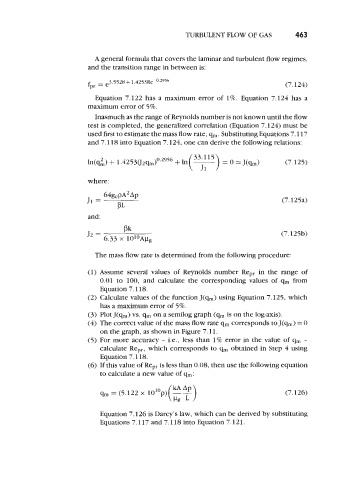Page 495 - Petrophysics
P. 495
TURBULENT FLOW OF GAS 463
A general formula that covers the laminar and turbulent flow regimes,
and the transition range in between is:
f - e3.5528 + 1.4253Rep0.2956
P' - (7.124)
Equation 7.122 has a maximum error of 1%. Equation 7.124 has a
maximum error of 5%.
Inasmuch as the range of Reynolds number is not known until the flow
test is completed, the generalized correlation (Equation 7.124) must be
used first to estimate the mass flow rate, qm. Substituting Equations 7.117
and 7.1 18 into Equation 7.124, one can derive the following relations:
(7.125)
where:
64gcpA2Ap
Ji = (7.125a)
PL
and:
Pk
52 = 6.33 x 10lOApg (7.125b)
The mass flow rate is determined from the following procedure:
Assume several values of Reynolds number Rep, in the range of
0.01 to 100, and calculate the corresponding values of qm from
Equation 7.118.
Calculate values of the function J(qm) using Equation 7.125, which
has a maximum error of 5%.
Plot J(qm) VS. qm on a semilog graph (qm is on the log-axis).
The correct value of the mass flow rate qm corresponds to J(qm) = 0
on the graph, as shown in Figure 7.1 1.
For more accuracy - ix., less than 1% error in the value of qm -
calculate Repr, which corresponds to qm obtained in Step 4 using
Equation 7.1 18.
If this value of Repr is less than 0.08, then use the following equation
to calculate a new value of qm:
( : : I
qm = (5.122 x 10"~) -- (7.126)
Equation 7.126 is Darcy's law, which can be derived by substituting
Equations 7.117 and 7.118 into Equation 7.121.

